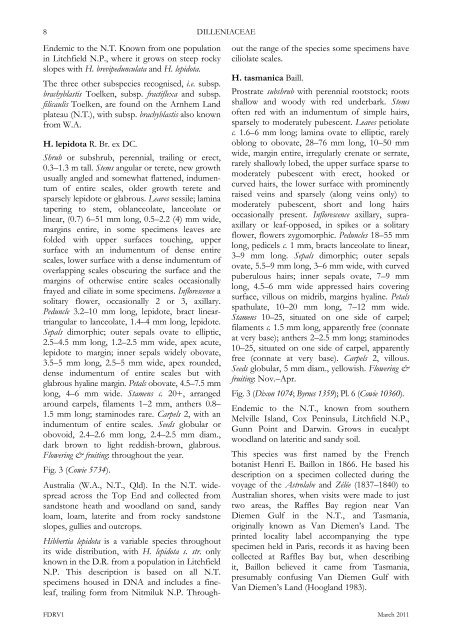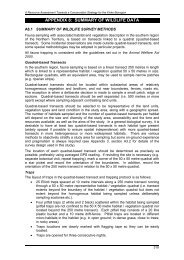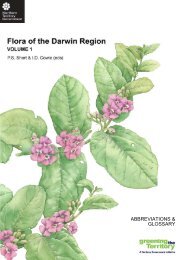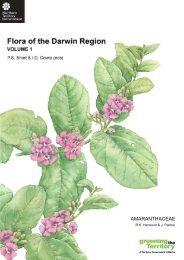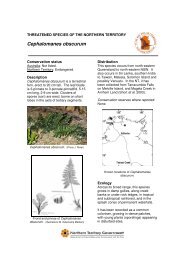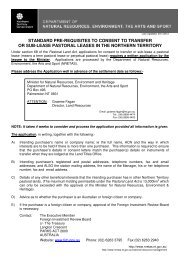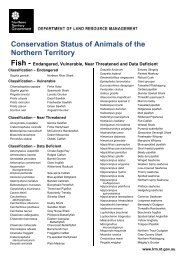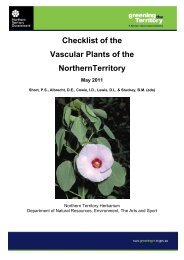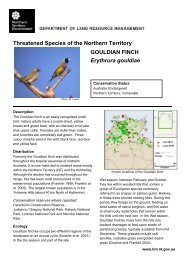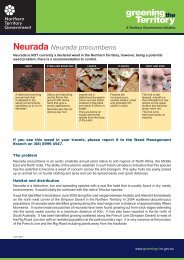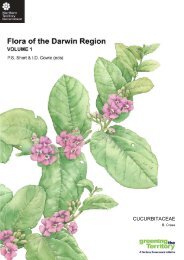DILLENIACEAE - Department of Land Resource Management ...
DILLENIACEAE - Department of Land Resource Management ...
DILLENIACEAE - Department of Land Resource Management ...
You also want an ePaper? Increase the reach of your titles
YUMPU automatically turns print PDFs into web optimized ePapers that Google loves.
8<br />
Endemic to the N.T. Known from one population<br />
in Litchfield N.P., where it grows on steep rocky<br />
slopes with H. brevipedunculata and H. lepidota.<br />
The three other subspecies recognised, i.e. subsp.<br />
brachyblastis Toelken, subsp. fractiflexa and subsp.<br />
filicaulis Toelken, are found on the Arnhem <strong>Land</strong><br />
plateau (N.T.), with subsp. brachyblastis also known<br />
from W.A.<br />
H. lepidota R. Br. ex DC.<br />
Shrub or subshrub, perennial, trailing or erect,<br />
0.3–1.3 m tall. Stems angular or terete, new growth<br />
usually angled and somewhat flattened, indumentum<br />
<strong>of</strong> entire scales, older growth terete and<br />
sparsely lepidote or glabrous. Leaves sessile; lamina<br />
tapering to stem, oblanceolate, lanceolate or<br />
linear, (0.7) 6–51 mm long, 0.5–2.2 (4) mm wide,<br />
margins entire, in some specimens leaves are<br />
folded with upper surfaces touching, upper<br />
surface with an indumentum <strong>of</strong> dense entire<br />
scales, lower surface with a dense indumentum <strong>of</strong><br />
overlapping scales obscuring the surface and the<br />
margins <strong>of</strong> otherwise entire scales occasionally<br />
frayed and ciliate in some specimens. Inflorescence a<br />
solitary flower, occasionally 2 or 3, axillary.<br />
Peduncle 3.2–10 mm long, lepidote, bract lineartriangular<br />
to lanceolate, 1.4–4 mm long, lepidote.<br />
Sepals dimorphic; outer sepals ovate to elliptic,<br />
2.5–4.5 mm long, 1.2–2.5 mm wide, apex acute,<br />
lepidote to margin; inner sepals widely obovate,<br />
3.5–5 mm long, 2.5–5 mm wide, apex rounded,<br />
dense indumentum <strong>of</strong> entire scales but with<br />
glabrous hyaline margin. Petals obovate, 4.5–7.5 mm<br />
long, 4–6 mm wide. Stamens c. 20+, arranged<br />
around carpels, filaments 1–2 mm, anthers 0.8–<br />
1.5 mm long; staminodes rare. Carpels 2, with an<br />
indumentum <strong>of</strong> entire scales. Seeds globular or<br />
obovoid, 2.4–2.6 mm long, 2.4–2.5 mm diam.,<br />
dark brown to light reddish-brown, glabrous.<br />
Flowering & fruiting: throughout the year.<br />
Fig. 3 (Cowie 5734).<br />
Australia (W.A., N.T., Qld). In the N.T. widespread<br />
across the Top End and collected from<br />
sandstone heath and woodland on sand, sandy<br />
loam, loam, laterite and from rocky sandstone<br />
slopes, gullies and outcrops.<br />
Hibbertia lepidota is a variable species throughout<br />
its wide distribution, with H. lepidota s. str. only<br />
known in the D.R. from a population in Litchfield<br />
N.P. This description is based on all N.T.<br />
specimens housed in DNA and includes a fineleaf,<br />
trailing form from Nitmiluk N.P. Through-<br />
<strong>DILLENIACEAE</strong><br />
out the range <strong>of</strong> the species some specimens have<br />
ciliolate scales.<br />
H. tasmanica Baill.<br />
Prostrate subshrub with perennial rootstock; roots<br />
shallow and woody with red underbark. Stems<br />
<strong>of</strong>ten red with an indumentum <strong>of</strong> simple hairs,<br />
sparsely to moderately pubescent. Leaves petiolate<br />
c. 1.6–6 mm long; lamina ovate to elliptic, rarely<br />
oblong to obovate, 28–76 mm long, 10–50 mm<br />
wide, margin entire, irregularly crenate or serrate,<br />
rarely shallowly lobed, the upper surface sparse to<br />
moderately pubescent with erect, hooked or<br />
curved hairs, the lower surface with prominently<br />
raised veins and sparsely (along veins only) to<br />
moderately pubescent, short and long hairs<br />
occasionally present. Inflorescence axillary, supraaxillary<br />
or leaf-opposed, in spikes or a solitary<br />
flower, flowers zygomorphic. Peduncles 18–55 mm<br />
long, pedicels c. 1 mm, bracts lanceolate to linear,<br />
3–9 mm long. Sepals dimorphic; outer sepals<br />
ovate, 5.5–9 mm long, 3–6 mm wide, with curved<br />
puberulous hairs; inner sepals ovate, 7–9 mm<br />
long, 4.5–6 mm wide appressed hairs covering<br />
surface, villous on midrib, margins hyaline. Petals<br />
spathulate, 10–20 mm long, 7–12 mm wide.<br />
Stamens 10–25, situated on one side <strong>of</strong> carpel;<br />
filaments c. 1.5 mm long, apparently free (connate<br />
at very base); anthers 2–2.5 mm long; staminodes<br />
10–25, situated on one side <strong>of</strong> carpel, apparently<br />
free (connate at very base). Carpels 2, villous.<br />
Seeds globular, 5 mm diam., yellowish. Flowering &<br />
fruiting: Nov.–Apr.<br />
Fig. 3 (Dixon 1074; Byrnes 1359); Pl. 6 (Cowie 10360).<br />
Endemic to the N.T., known from southern<br />
Melville Island, Cox Peninsula, Litchfield N.P.,<br />
Gunn Point and Darwin. Grows in eucalypt<br />
woodland on lateritic and sandy soil.<br />
This species was first named by the French<br />
botanist Henri E. Baillon in 1866. He based his<br />
description on a specimen collected during the<br />
voyage <strong>of</strong> the Astrolabe and Zélée (1837–1840) to<br />
Australian shores, when visits were made to just<br />
two areas, the Raffles Bay region near Van<br />
Diemen Gulf in the N.T., and Tasmania,<br />
originally known as Van Diemen’s <strong>Land</strong>. The<br />
printed locality label accompanying the type<br />
specimen held in Paris, records it as having been<br />
collected at Raffles Bay but, when describing<br />
it, Baillon believed it came from Tasmania,<br />
presumably confusing Van Diemen Gulf with<br />
Van Diemen’s <strong>Land</strong> (Hoogland 1983).<br />
FDRV1 March 2011


